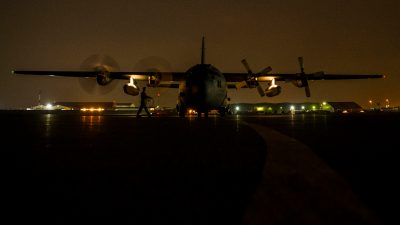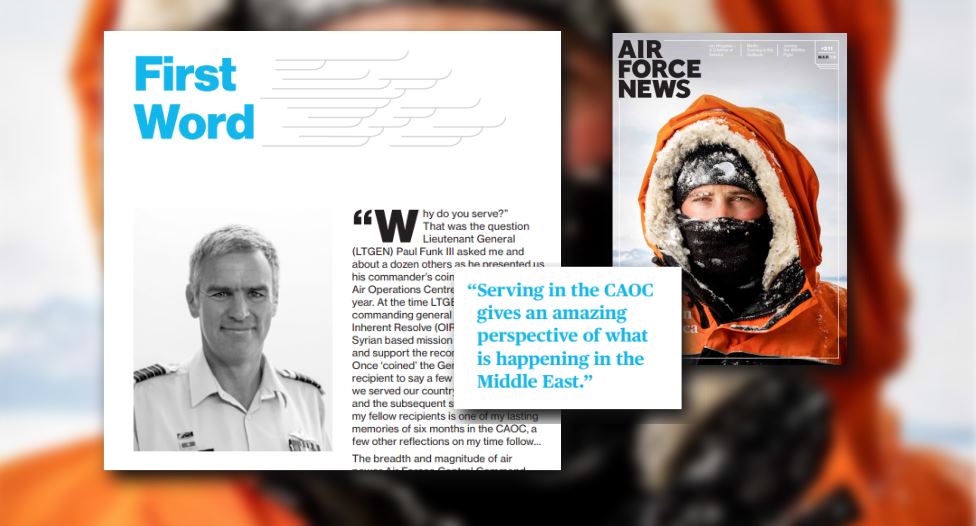New Zealand’s Hidden Role at the Biggest US Bombing Base in the Middle East

A recent issue of Air Force News revealed that a senior NZDF officer served a six-month posting at the Qatar base, placing New Zealanders at the heart of the main targeting and bombing center in that region, writes Darius Shahtahmasebi
***
Last month the coalition government declared the end of New Zealand Defence Force deployments in Iraq. The announcement was silent, however, about the future of another deployment of New Zealand personnel, to a U.S. military base in the Middle East that has attracted controversy thanks to its role at the center of a large proportion of U.S. bombing missions in the region.
The base is called the Combined Air Operations Center (CAOC) and it is located at the Al-Udeid airbase in the small Persian Gulf nation of Qatar. Bombing missions that have been controlled from the base – where aircraft take off and land every 10 minutes, 24 hours a day – are implicated in large numbers of civilian casualties.
A recent issue of Air Force News revealed that a senior air force officer, Group Captain Shaun Sexton, served a six-month posting at the Qatar base; placing New Zealanders at the heart of the main targeting and bombing center in that region. The presence of New Zealand staff at the base has been kept largely quiet by the New Zealand military before now.
Last month, the New Zealand government delivered its decision to withdraw NZDF personnel from Iraq by next year. But what of Qatar? A spokesperson for NZDF told the Spinoff that “NZDF personnel based in the Combined Air Operations Center (CAOC) operate under a separate mandate to the NZDF personnel in Iraq. This mandate has been approved until 2020.” Whether they intend to maintain the postings to the Qatar base after 2020 remains unclear.

According to information released by NZDF in response to an Official Information Act request, there are five New Zealand personnel currently serving at the Al-Udeid Airbase. Two of the troops coordinate air tasking in support of the Combined Maritime Forces, Operation Inherent Resolve (Iraq and Syria) and the Resolute Support (Afghanistan) mission. New Zealand also has three personnel supporting intelligence functions within the U.S. Central Command Forward Headquarters at the base.
NZDF confirmed that New Zealand personnel at the COAC work across all regional operations, including those in Syria, where the legality of U.S.-led operations has been thoroughly questioned (although the NZDF states that its troops are not involved in combat operations). NZDF said that because the way the CAOC operates, it is not practical to delineate participation on a country-by-country basis.
The base was responsible for 8,713 airstrikes (or weapons released) in 2018, 39,577 strikes in 2017 and 30,743 in 2016 (including both manned and unmanned aircraft).
Group Captain Shaun Sexton told Air Force magazine that “serving in the CAOC gives an amazing perspective of what is happening in the Middle East”.
He added:
“You truly get a birds-eye view, allowing fascinating insight into the politics and tensions in a key region of the world and into the employment of military effects, especially air power.”
In March 2015, a former chief of the operations division at the base, Lt Col David Haworth, told the Associated Press that “what we are doing today would [not] be even remotely possible without the coalition partners.” This included intelligence gathering.
According to Sexton,
“most of the people serving in the CAOC are from the United States Air Force. However, the other 15 nations in the coalition have a huge role to play.”
He continued: “The contribution they make to the fight in terms of people and hardware is significant.”
A Stuff Circuit report last year suggested that NZDF personnel had been secretly operating at the CAOC at Al-Udeid since at least 2016.
Reports indicate that coalition aircraft flying out of the CAOC have been responsible for anywhere between 10 percent to 20 percent of sorties flown in Iraq and Syria during Operation Inherent Resolve. In addition, the airbase is the “nerve center” of U.S.-led air campaigns across the region, managing and directing air operations in not only Iraq, Syria and Afghanistan, but in 18 other countries.
Approximately 40 percent of all strikes in Iraq and Syria have been delivered by the B1 Bomber, an aircraft that has only been departing from the airbase at Al-Udeid.
The CAOC was pivotal in the U.S.-led battle to retake Mosul from ISIS militants. During the early stages of the offensive, U.S.-led airstrikes pounded Mosul every eight minutes.
However, an AP report found an appalling rate of civilian casualties during the operation. It reported that some 9,000 to 11,000 civilians had died, nearly ten times what had been previously reported in the media. This number did not take into account dead still buried underneath the rubble.
The Qatar airbase also has undertaken a crucial role in the Syrian war. The fight to retake ISIS’s de-facto Syrian capital city of Raqqa saw the U.S. military raze approximately 80 percent of the city to the ground.
A Raqqan resident told Reuters that corpses were rotting on the street, with cats eating their bodies. This offensive was further mired by a special BBC report which found that the U.S. military had made a secret arrangement to allow hundreds of ISIS commanders and fighters to escape Raqqa unscathed. Reuters subsequently reported that the number of escaped ISIS fighters numbered in the thousands.
The base also played a part in US P.r.esident Donald Trump’s April 2018 bombing of Syrian government assets in response to an alleged chemical weapons attack, another controversial use of force.
The NZDF spokesperson said the organization is confident its personnel on all operations are conducting themselves in accordance with both domestic and international legal obligations.
*
Note to readers: please click the share buttons above or below. Forward this article to your email lists. Crosspost on your blog site, internet forums. etc.
Darius Shahtahmasebi is a New Zealand-based legal and political analyst who focuses on US foreign policy in the Middle East, Asia and Pacific region. He is fully qualified as a lawyer in two international jurisdictions.
Featured image: A U.S. Air Force C-130 Hercules at Baghdad International Airport, Iraq, Dec. 9, 2019. Bethany E. La Ville | DVIDS

